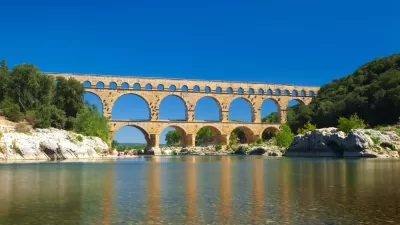Los Angeles made progress toward revitalizing the L.A. River when the preferred restoration plan won an important approval. But the project also saw a jump in price and a change in cost-share, leaving some wondering where the money will come from.
The broad coalition involved in the revitalization project includes the mayor’s LARiverWorks team and the LA River Revitalization Corporation, as well as established community organization Friends of the Los Angeles River (FoLAR). FoLAR founder Lewis MacAdams and City of Los Angeles Deputy Mayor Barbara Romero, who oversees LARiverWorks, gave The Planning Report their expert perspectives on the questions facing the river’s future.
The new $1.36-billion price tag may be daunting, but development of the river is by all accounts a long-term investment—the city's master plan has a 25-to-50-year horizon. And, MacAdams points out, “People are not batting an eye about spending $2 billion to buy the Clippers or to build a football stadium. This project will bring a lot more happiness to a lot more people than a football team will.”
The real issue, says MacAdams, is the amount of that total cost currently expected to come from local sources: "The 80-20 split between local and federal funding needs to be changed, because it puts parts of the restoration in danger."
Possible options to cover the local share of the plan include establishing an Enhanced Infrastructure Financing District—a state financing tool the city’s been eyeing since it came into effect this year.
MacAdams and Romero agree on many fronts, but the question of governance revealed differing views.
According to MacAdams, an artist-turned-activist whose work on the river has spanned five mayoral administrations, Los Angeles' governance structure for the river is “obsolete.”
The L.A. River Revitalization Corporation’s decision to bring on Frank Gehry didn't inspire a vote of confidence from the longtime community activist. MacAdams called Gehry’s involvement an example of “top-down planning…the opposite of what Friends of the Los Angeles River is about.” Gehry’s suggestion that he may retain the river’s concrete has also raised some concerns about his vision’s compatibility with Alternative 20.
But Romero says the mayor’s creation of the LARiverWorks team already signals a collaborative approach, bringing city departments together in cooperation with the private sector and regional bodies. To make drastic changes at this point, she says, would be premature until solid funding is identified:
“Ultimately, governance is about funding. I don’t think we’ll go with a new governance structure if there’s no money attached to it. We have some work to do collectively to determine: What is our priority in these next several years in implementation? I think the number one priority today is starting to put more significant projects on the ground.”
FULL STORY: Romero and MacAdams: Who Will Plan & Fund LA River Revitalization?

Alabama: Trump Terminates Settlements for Black Communities Harmed By Raw Sewage
Trump deemed the landmark civil rights agreement “illegal DEI and environmental justice policy.”

Study: Maui’s Plan to Convert Vacation Rentals to Long-Term Housing Could Cause Nearly $1 Billion Economic Loss
The plan would reduce visitor accommodation by 25% resulting in 1,900 jobs lost.

Planetizen Federal Action Tracker
A weekly monitor of how Trump’s orders and actions are impacting planners and planning in America.

Waymo Gets Permission to Map SF’s Market Street
If allowed to operate on the traffic-restricted street, Waymo’s autonomous taxis would have a leg up over ride-hailing competitors — and counter the city’s efforts to grow bike and pedestrian on the thoroughfare.

Parklet Symposium Highlights the Success of Shared Spaces
Parklets got a boost during the Covid-19 pandemic, when the concept was translated to outdoor dining programs that offered restaurants a lifeline during the shutdown.

Federal Homelessness Agency Places Entire Staff on Leave
The U.S. Interagency Council on Homelessness is the only federal agency dedicated to preventing and ending homelessness.
Urban Design for Planners 1: Software Tools
This six-course series explores essential urban design concepts using open source software and equips planners with the tools they need to participate fully in the urban design process.
Planning for Universal Design
Learn the tools for implementing Universal Design in planning regulations.
Caltrans
Smith Gee Studio
Institute for Housing and Urban Development Studies (IHS)
City of Grandview
Harvard GSD Executive Education
Toledo-Lucas County Plan Commissions
Salt Lake City
NYU Wagner Graduate School of Public Service





























